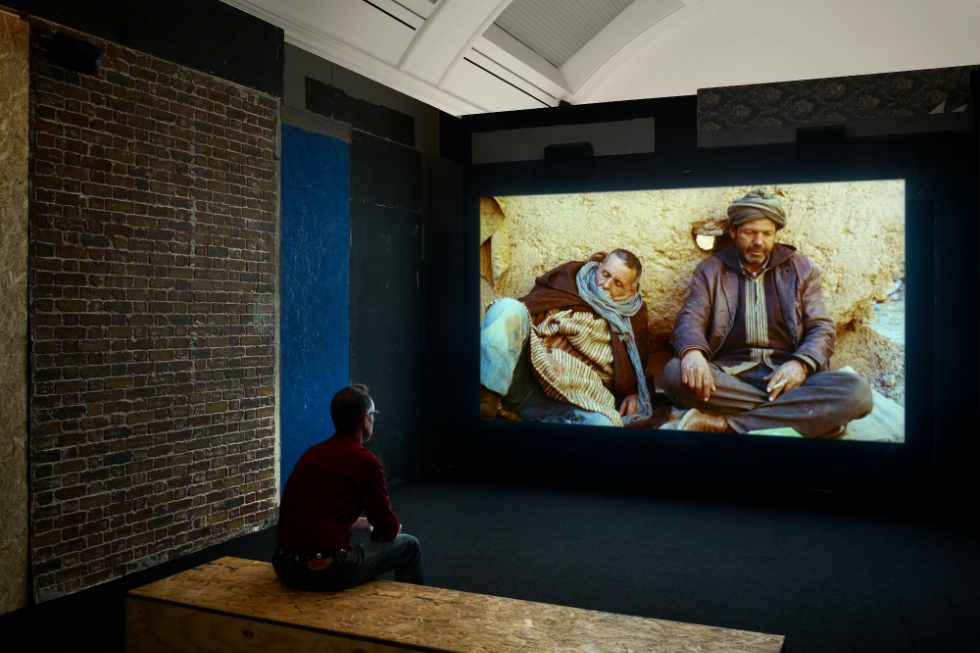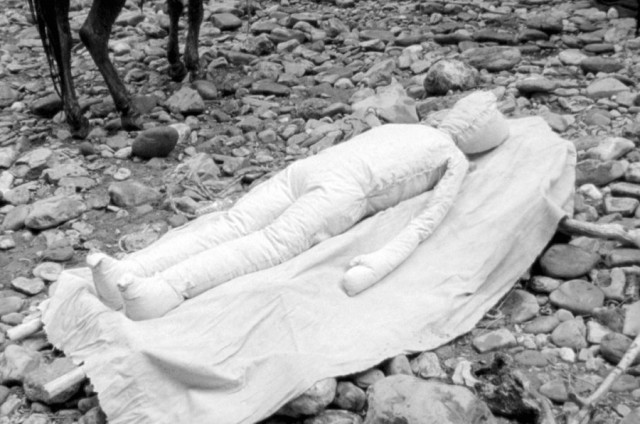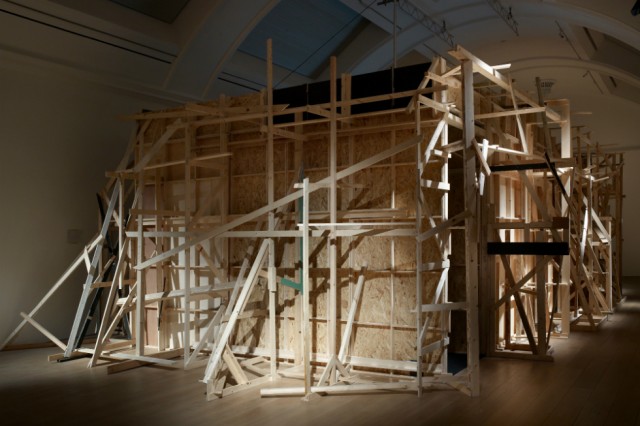Bandits, Banality & Lies: Ben Rivers’ The Two Eyes Are Not Brothers

Jacob Charles Wilson gets to grips with Ben River’s ‘labyrinthine’ film installations, and concludes that all stories, heard or read, are to some extent lies…
The Whitworth Art Gallery’s recent renovation has revitalised the institute, expanded the galleries and the cafe, and brought with it a number of stunning exhibitions. The gallery is currently hosting Ben Rivers’ latest art film installation, The Two Eyes Are Not Brothers (2015), a project of labyrinthine complexity comprising numerous fragments of film, sound work, and production props. This exhibition explores themes common to Rivers’ earlier work, treading an ambiguous line between the literal and metaphorical, myth and memory. Talking with Rivers amidst the works, he tells me: “They’re two very different things, there’s always a kind of fiction taking place… That intersection has been something that I’ve been fascinated by, and with this project it’s really brought to the foreground; the act of making cinema and making worlds”.
Rivers’ prior films saw him construct characters and scenarios at once grounded in the world and yet somehow removed from it. In his award-winning Two Years at Sea (2011) Rivers follows Jake Williams, an old merchant-sailor ensconced on a remote Scottish Island, whom the artist exaggerates and characterises as a hermit; while in A Spell To Ward Off The Darkness (2013) Rivers, collaborating with artist Ben Russell, follows an unnamed figure through three episodes of their life, living first in a Estonian commune, then alone in the Finnish wilderness, and as the frontman of a black metal band in Norway.
His latest and largest project, The Two Eyes Are Not Brothers, initially began as a documentary following the film work of his friends and colleagues Oliver Laxe (actor/director) and Shezad Dawood (artist), who were each independently shooting in Morocco. Whilst in the midst of this work, Rivers recalled his long-standing interest in the writings of Paul Bowles, an American writer who lived and worked in Morocco from the 1940s. In Bowles’ 1947 short story A Distant Episode, a European linguist, known only as The Professor, travels to North Africa and is captured by nomads, tortured and dressed in a suit of tin-can lids, and forced to dance for his captors’ amusement. These two strands of work separated by nearly 70 years come together in Rivers’ own surreal interpretation, the ominous title of which derives from comments overheard by Bowles whilst sitting in a Moroccan cafe; a man, high on kif (a sort of hashish), uttered the phrase: “The sky trembles and the earth is afraid, and the two eyes are not brothers”.
Rivers’ project is daunting due to its size and scope, and he admits that this is one of his most complex creations. The three exhibition galleries of the Whitworth feature short clips, out-takes, and behind-the-scenes footage, all filmed on an analogue 16mm camera. These fragments derive from Rivers’ work documenting Laxe’s Las Mimosas (forthcoming) and also comprise Rivers’ own feature film, The Sky Trembles and The Earth is Afraid and The Two Eyes Are Not Brothers (2015). A second film by Rivers entitled A Distant Episode, made using footage from Dawood’s film Towards the Possible Film (2014), is shown in the central gallery. The can-lid suit worn on camera by Laxe is hung in the Darbishire Hall; standing in front of this you can hear an audio extract of Pere Portabella’s Vampir Cuadecuc (1971), a film that Rivers found influential to his direction.

If there is one place where a structure to the project is offered it’s within the pages of the book made to accompany the project, in which notes and production stills are laid like a scrapbook. But for Rivers, none of these should be seen as isolated works, rather as references to one-another, to be read and re-read as a whole.
Rivers’ project is fundamentally concerned with authenticity; exploring the act of filmmaking itself through scenes which rest on an uneasy shifting ground of real and performed. In presenting the act of filmmaking, and in drawing on older works of fiction, Rivers asks what it means to tell and retell a story, to move between contexts and to work with new surroundings and new audiences. He poses the question: Is the original more real than the copy?
The Whitworth exhibition itself has been staged once before – co-commissioned alongside ArtAngel and the BFI’s Film Fund with the support of Arts Council England, and first exhibited in the old West London BBC Television Centre in White City. With the old studios now demolished and the departments moved to MediaCity in Salford, Ben Rivers’ project comes in its wake to premiere with audiences in the North. Talking with assistant curator Matthew Retallick, he tells me that The Whitworth’s installation is not supposed to compete with, or replicate, the experience of that at the old BBC studios, but that the installation and materials transported to Manchester should be re-read in its new surroundings.
The structures that contain the screens and projectors recall the abandoned film sets strewn throughout Morocco; long a fashionable location for shooting ‘desert’ scenes in films such as Lawrence of Arabia (1962) and Othello (1965). This found-architecture resonates with Rivers’ early experience working for a special effects company, and embodies the architecture of the film itself – confused, messy, and layered. At White City, this architecture fell into the background of real derelict surroundings. In the new galleries of the Whitworth, celebrating its one-year anniversary since the renovation, Rivers’ installation may be read less as a convenient backdrop for a film screening, and more as a collection of art objects to be considered as much as the films themselves.

Rivers’ work demonstrates the fact that film-making is largely an act of repetition, most of which accounts for nothing, as scenes get shot, reshot, and then often discarded. Takes have to be staged multiple times from different angles, with different light levels; particularly when, as in this film, Rivers worked on location with untrained actors. There’s a banality behind even the most dramatic and emotive scenes. The south gallery features scenes from the “bandits’ camp” which begin with two men slouched asleep; after a couple of minutes a direction is yelled, and together the two men wake and admire something hidden offscreen. As the camera observes the scene, suddenly directions are called and simultaneously translated, microphones and clapperboards emerge from off-camera, piercing the illusion of naturalness. The labour of performance is emphasised in the numerous clips of Laxe dancing hidden under the tincan suit. As Laxe stumbles and staggers, with each clip the camera moves between him and his shadow cast onto the walls. In this fragmented showing we also experience scenes that make little sense before being spliced into the film. In Las Mimosas’ Lab Roll, projected in the north gallery, the camera observes the film crew throwing cardboard boxes in a pile in a river gorge, before an embalmed body floats down the river.
In his short film of Mohammed Mrabet, Rivers plays with the sense of authenticity and witness, forming a direct link between himself and Bowles, engaging with the issue of retelling the story, authenticity and translation. At some point in the 1960s, Paul and Jane Bowles befriended Mrabet, an illiterate fisherman and painter with a passion for oral storytelling, and worked with him to transcribe and translate Mrabet’s tales from his native Moghrebi into English. However, Mrabet later found that Bowles’ translations were not as true to his originals as expected. Mrabet also accused Bowles of plagiarising his stories and profiting from the translations. In the film, Mrabet, now 79, sits in a cave beside a younger man, and tells an anecdote about a time he worked as a waiter at a party for foreigners, and smoked kif with an American woman whose husband was a writer. There’s a suggestion that this is perhaps a genuine memory of the first time he met Jane Bowles. But equally, this could simply be a framing device for the joke that he slowly rolls into.
Mrabet’s own experiences and comments highlight the need for visitors to the exhibition to become attentive to the contexts in which they hear the stories retold and replayed. The dislocation of works across temporal, geographical and cultural boundaries is rampant and for many people from Britain an issue that they are only just coming to terms with. There’s a long European colonial history of ethnographic film, notably Jean Rouch’s 1955 ‘ethnofiction’ Les Maitres Fous.
I ask Rivers about his relation to this history and whether his project is a direct interrogation of Bowles himself. Rivers sees himself as necessarily bound to this history, and that the project is an interrogation of Bowles’ relationship to Morocco, but also Rivers’ own relationship – “as an outsider, as a white European filmmaker who does occasionally like to travel and make films in places that aren’t my own”. For Rivers, it is Rouch’s later work which has had the greatest effect: those films where Rouch, recognising that his presence influenced the subject matter and inevitably led to a lack of objectivity in documentaries, began to introduce further deliberate fictions into his films and writing. This is something that reaches back to Mrabet’s own conception of his work, saying that all stories, heard or read, are to some extent lies.
Jacob Charles Wilson
See The Two Eyes Are Not Brothers at The Whitworth Art Gallery, Manchester, until Sunday 22 May 2016 — FREE entry
The Two Eyes Are Not Brothers is commissioned by Artangel, The Whitworth, Manchester, and the BFI’s Film Fund, with the support of Arts Council England. It was selected through Open by Artangel and BBC Radio 4
Images: from top: Installation image: Ben Rivers, The Two Eyes Are Not Brothers at the Whitworth, 2016. Photo by Michael Pollard. Courtesy the Whitworth; dummy, courtesy of the artist and Kate MacGarry, London, photography credit, Yuki Yamamoto; installation image by Michael Pollard. Courtesy the Whitworth. Featured image: tin man, courtesy of the artist and Kate MacGarry, London, photography credit, Yuki Yamamoto.





